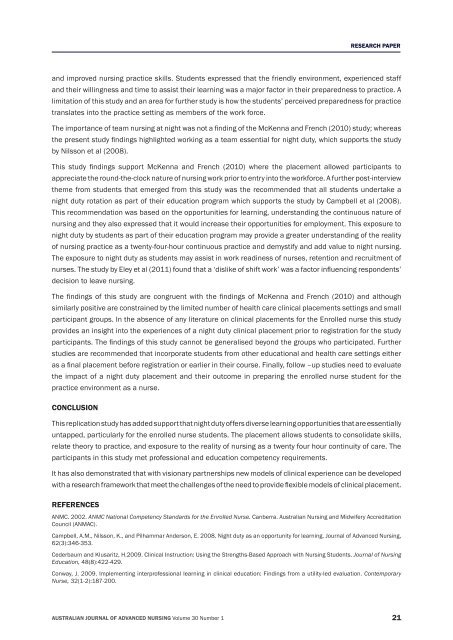Download Complete Issue - Australian Journal of Advanced Nursing
Download Complete Issue - Australian Journal of Advanced Nursing
Download Complete Issue - Australian Journal of Advanced Nursing
You also want an ePaper? Increase the reach of your titles
YUMPU automatically turns print PDFs into web optimized ePapers that Google loves.
RESEARCH PAPER<br />
and improved nursing practice skills. Students expressed that the friendly environment, experienced staff<br />
and their willingness and time to assist their learning was a major factor in their preparedness to practice. A<br />
limitation <strong>of</strong> this study and an area for further study is how the students’ perceived preparedness for practice<br />
translates into the practice setting as members <strong>of</strong> the work force.<br />
The importance <strong>of</strong> team nursing at night was not a finding <strong>of</strong> the McKenna and French (2010) study; whereas<br />
the present study findings highlighted working as a team essential for night duty, which supports the study<br />
by Nilsson et al (2008).<br />
This study findings support McKenna and French (2010) where the placement allowed participants to<br />
appreciate the round‐the‐clock nature <strong>of</strong> nursing work prior to entry into the workforce. A further post‐interview<br />
theme from students that emerged from this study was the recommended that all students undertake a<br />
night duty rotation as part <strong>of</strong> their education program which supports the study by Campbell et al (2008).<br />
This recommendation was based on the opportunities for learning, understanding the continuous nature <strong>of</strong><br />
nursing and they also expressed that it would increase their opportunities for employment. This exposure to<br />
night duty by students as part <strong>of</strong> their education program may provide a greater understanding <strong>of</strong> the reality<br />
<strong>of</strong> nursing practice as a twenty‐four‐hour continuous practice and demystify and add value to night nursing.<br />
The exposure to night duty as students may assist in work readiness <strong>of</strong> nurses, retention and recruitment <strong>of</strong><br />
nurses. The study by Eley et al (2011) found that a ‘dislike <strong>of</strong> shift work’ was a factor influencing respondents’<br />
decision to leave nursing.<br />
The findings <strong>of</strong> this study are congruent with the findings <strong>of</strong> McKenna and French (2010) and although<br />
similarly positive are constrained by the limited number <strong>of</strong> health care clinical placements settings and small<br />
participant groups. In the absence <strong>of</strong> any literature on clinical placements for the Enrolled nurse this study<br />
provides an insight into the experiences <strong>of</strong> a night duty clinical placement prior to registration for the study<br />
participants. The findings <strong>of</strong> this study cannot be generalised beyond the groups who participated. Further<br />
studies are recommended that incorporate students from other educational and health care settings either<br />
as a final placement before registration or earlier in their course. Finally, follow –up studies need to evaluate<br />
the impact <strong>of</strong> a night duty placement and their outcome in preparing the enrolled nurse student for the<br />
practice environment as a nurse.<br />
CONCLUSION<br />
This replication study has added support that night duty <strong>of</strong>fers diverse learning opportunities that are essentially<br />
untapped, particularly for the enrolled nurse students. The placement allows students to consolidate skills,<br />
relate theory to practice, and exposure to the reality <strong>of</strong> nursing as a twenty four hour continuity <strong>of</strong> care. The<br />
participants in this study met pr<strong>of</strong>essional and education competency requirements.<br />
It has also demonstrated that with visionary partnerships new models <strong>of</strong> clinical experience can be developed<br />
with a research framework that meet the challenges <strong>of</strong> the need to provide flexible models <strong>of</strong> clinical placement.<br />
REFERENCES<br />
ANMC. 2002. ANMC National Competency Standards for the Enrolled Nurse. Canberra. <strong>Australian</strong> <strong>Nursing</strong> and Midwifery Accreditation<br />
Council (ANMAC).<br />
Campbell, A.M., Nilsson, K., and Pilhammar Anderson, E. 2008. Night duty as an opportunity for learning. <strong>Journal</strong> <strong>of</strong> <strong>Advanced</strong> <strong>Nursing</strong>,<br />
62(3):346‐353.<br />
Cederbaum and Klusaritz, H.2009. Clinical Instruction: Using the Strengths‐Based Approach with <strong>Nursing</strong> Students. <strong>Journal</strong> <strong>of</strong> <strong>Nursing</strong><br />
Education, 48(8):422‐429.<br />
Conway, J. 2009. Implementing interpr<strong>of</strong>essional learning in clinical education: Findings from a utility‐led evaluation. Contemporary<br />
Nurse, 32(1‐2):187‐200.<br />
AUSTRALIAN JOURNAL OF ADVANCED NURSING Volume 30 Number 1 21

















